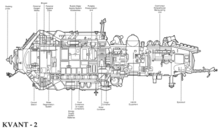Kwant 2
| Mission dates | |
|---|---|
| Mission: | Kwant-2 |
| Crew: | unmanned |
| Target: | Me |
| Start vehicle: | proton |
| Start on: | November 26, 1989 / Baikonur |
| Coupling on: | December 6, 1989 |
| Decoupling on: | - |
| Re-entry on: | March 23, 2001 |
| Flight duration: | ? |
| burns up over: | Pacific |
| Earth orbits: | ? |
|
previous DCS mission : |
following DCS mission : |
Kwant-2 ( Russian Квант-2 ' Quant -2') is the name of a scientific module that was docked on the Soviet Mir space station .
development
After the modules of type 37K for the Mir space station had been deleted in 1983, modules were again developed on the basis of the TKS spaceship , which already provided the basis for the Kosmos 1686 module . The fixed combination of the TKS drive part with the equipment part resulted in a large module weighing around 19 tons and around 61 cubic meters of pressurized volume. Kwant-2 was the first of four TKS-based modules to expand the Mir. With Kwant-2, the Mir should be significantly enlarged and important systems for operating the space station expanded. Another task was to improve the living and working conditions for the cosmonauts . Kwant-2 contained a digital computer of the type "Salyut-5B" to control the space station, which could not be started with the base block. Furthermore, Kwant-2 carried a second set of three gyroscopes , which in combination with the gyroscopes of the already docked Kwant module enabled the position control of the Mir complex largely without fuel consumption. In addition, the drives of the TKS drive part could be used to control the position of the Mir. In addition, Kwant-2 (in contrast to type 37K modules) had its own solar cells and accumulators to supply the complex with energy. Instead of a Merkur landing capsule, Kwant-2 was equipped with a large airlock one meter in diameter. Another bulkhead separated the storage area from the laboratory area. This enabled the crew to divide the pressure equalization module into three compartments, which enabled cosmonauts to exit into free space in large controllable spacesuits of the "Ikarus" type. With these suits brought by Kwant, installation work on the outer skin of the complex could be carried out. Furthermore, Kwant-2 has been equipped with new life support systems for reusing water and producing oxygen. To improve personal hygiene on board the Mir, in addition to a toilet, Kwant-2 also had a shower and wash cell for use in weightlessness.
The mission
The launch of Kwant-2 was originally scheduled for March 1989, but had to be postponed due to malfunctions in the automatic course docking system. Finally, on November 26, 1989, the launch on board a Proton rocket from the Baikonur spaceport took place. During the autonomous flight, when the systems were commissioned and tested, problems arose with the deployment of the sun sails and in the docking system, so that the docking maneuver planned for December 2nd could not be carried out. After the interference by the ground control had been eliminated, the docking maneuver at the front axial docking nozzle of the Mir base block succeeded on December 6, 1989. With the help of a robotic arm, Kwant-2 was moved two days later to the final radial position of the Mir coupling node, where Kwant-2 remained over the entire service life of the space station. After around 12 years in space, Kwant-2 crashed together with the other modules of the complex on March 23, 2001 in a controlled manner over the Pacific.
Scientific tasks
In addition to the expansion components for the operation of the Mir space station, Kwant-2 also had scientific equipment. Research focussed on biology, astronomy and earth observation. Among other things, an experiment in poultry farming in weightlessness became known. The breeding of quails was tested as a possible source of meat for long-term missions, for example to Mars . Through a large built-in observation window, recordings of objects under observation could be made with the help of various cameras. The equipment also included a multispectral camera ( MKF 6 M) manufactured in the former GDR . A mobile, remote-controlled platform was located on the outer skin, which enabled the tracking and scientific observation of astronomical objects autonomously.
Conclusions
With Kwant-2 it was confirmed that a module combined from the TKS drive part and a variable piece of equipment has a favorable ratio of take-off mass to usable volume. The high level of compatibility of the TKS part made it possible to set up specialized modules for performing different tasks by adding different components. All other Russian Mir modules were built on the same principle after the success of Kwant-2. On the basis of the TKS ferry, modules for permanent stay at the International Space Station (ISS) (e.g. Sarja ) are being developed to this day.
swell
- Harland, David M .; The story of Space Station Mir , Springer-Verlag, Berlin Heidelberg New York 2005, ISBN 0-387-23011-4
Web links
- Kwant 2 in the Encyclopedia Astronautica (English)





